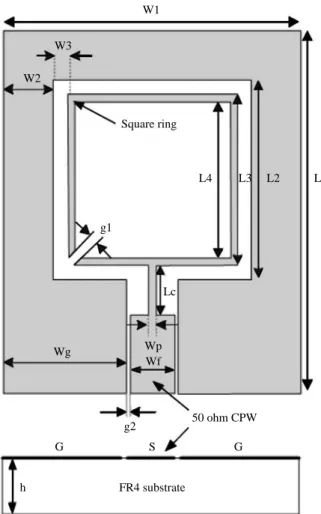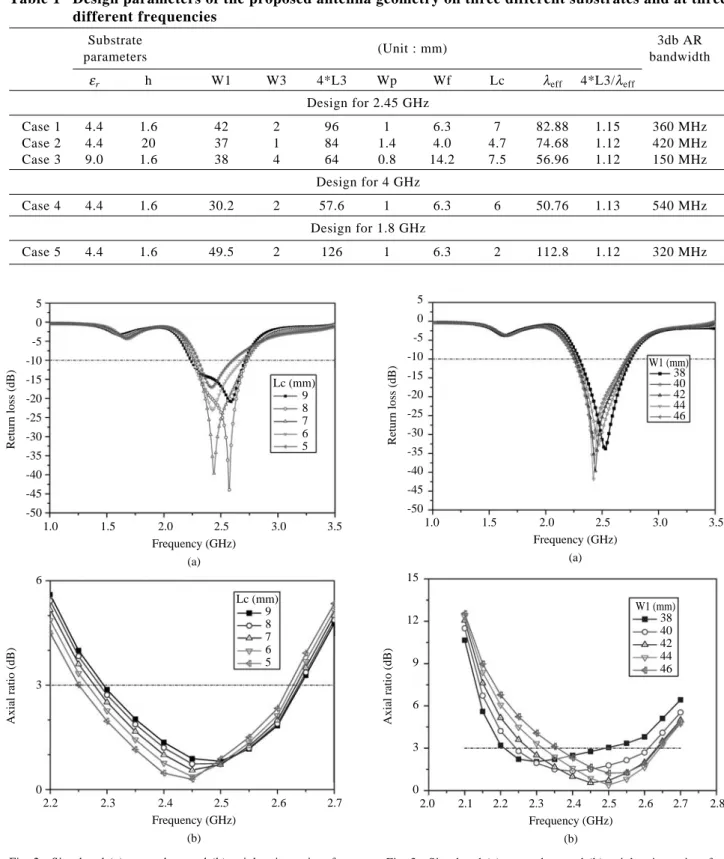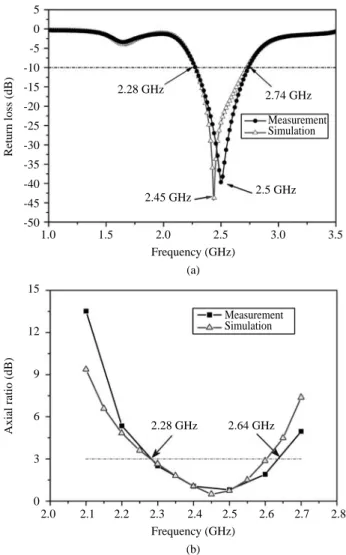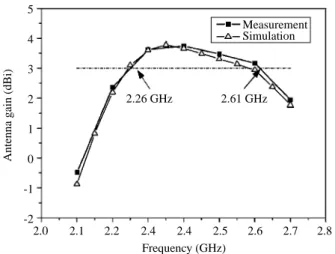This article was downloaded by: [National Chiao Tung University 國立交通大學] On: 25 April 2014, At: 08:10
Publisher: Taylor & Francis
Informa Ltd Registered in England and Wales Registered Number: 1072954 Registered office: Mortimer House, 37-41 Mortimer Street, London W1T 3JH, UK
Journal of the Chinese Institute of Engineers
Publication details, including instructions for authors and subscription information:
http://www.tandfonline.com/loi/tcie20
A novel design of a cpw
‐fed single square‐loop
antenna for circular polarization
I‐Chung Deng a , Ren‐Jie Lin b , Qing‐Xiang Ke c , Jia‐Min Huang c & Kow‐Ming Chang b a
Department of Electronics Engineering and Institute of Mechatronic Engineering , Technology and Science Institute of Northern Taiwan , Taipei, Taiwan 112, R.O.C. Phone: 886–2–28927154 ext. 8408 Fax: 886–2–28927154 ext. 8408 E-mail:
b
Department of Electronics Engineering and Institute of Electronics , National Chiao Tung University , Hsinchu, 30050, Taiwan, R.O.C.
c
Department of Electronics Engineering and Institute of Mechatronic Engineering , Technology and Science Institute of Northern Taiwan , Taipei, Taiwan 112, R.O.C. Published online: 04 Mar 2011.
To cite this article: I‐Chung Deng , Ren‐Jie Lin , Qing‐Xiang Ke , Jia‐Min Huang & Kow‐Ming Chang (2008) A novel design
of a cpw‐fed single square‐loop antenna for circular polarization, Journal of the Chinese Institute of Engineers, 31:6, 1095-1100, DOI: 10.1080/02533839.2008.9671464
To link to this article: http://dx.doi.org/10.1080/02533839.2008.9671464
PLEASE SCROLL DOWN FOR ARTICLE
Taylor & Francis makes every effort to ensure the accuracy of all the information (the “Content”) contained in the publications on our platform. However, Taylor & Francis, our agents, and our licensors make no
representations or warranties whatsoever as to the accuracy, completeness, or suitability for any purpose of the Content. Any opinions and views expressed in this publication are the opinions and views of the authors, and are not the views of or endorsed by Taylor & Francis. The accuracy of the Content should not be relied upon and should be independently verified with primary sources of information. Taylor and Francis shall not be liable for any losses, actions, claims, proceedings, demands, costs, expenses, damages, and other liabilities whatsoever or howsoever caused arising directly or indirectly in connection with, in relation to or arising out of the use of the Content.
This article may be used for research, teaching, and private study purposes. Any substantial or systematic reproduction, redistribution, reselling, loan, sub-licensing, systematic supply, or distribution in any
form to anyone is expressly forbidden. Terms & Conditions of access and use can be found at http:// www.tandfonline.com/page/terms-and-conditions
A NOVEL DESIGN OF A CPW-FED SINGLE SQUARE-LOOP
ANTENNA FOR CIRCULAR POLARIZATION
I-Chung Deng*, Ren-Jie Lin, Qing-Xiang Ke, Jia-Min Huang and Kow-Ming Chang
ABSTRACT
The experimental and simulated results for the proposed antenna are investi-gated in this article. Moreover, a novel broadband design of a circularly polarized (CP) single square slot antenna fed by a single coplanar waveguide is presented. By appropriately choosing the circumference of the square-loop, the length of the pro-truded strip, and the gap, this proposed antenna thus owns good CP radiation and good impedance match simultaneously at the frequency of 2.45 GHz. This proposed antenna has the fundamental resonant frequency of 2.5 GHz with the minimum return loss of -39.9 dB. Furthermore, its impedance bandwidth is 460 MHz or 18.4% and 3-dB axial-ratio (AR) bandwidth is 360 MHz or 14.4% at 2.5 GHz.
Key Words: circularly polarized, square slot antenna, coplanar waveguide, axial ratio.
*Corresponding author. (Tel: 886-2-28927154 ext. 8408; Fax: 886-2-28920674; Email: icdeng@tsint.edu.tw)
I. C. Deng, Q. X. Ke and J. M. Huang are with the Department o f E l e c t r o n i c s E n g i n e e r i n g a n d I n s t i t u t e o f M e c h a t r o n i c Engineering, Technology and Science Institute of Northern Taiwan, Taipei, Taiwan 112, R.O.C.
R. J. Lin and K. M. Chang are with the Department of Electron-ics Engineering and Institute of ElectronElectron-ics, National Chiao Tung University, Hsinchu, Taiwan 30050, R.O.C.
I. INTRODUCTION
Advantageously, circularly polarized (CP) an-tennas radiate nearly constant radiation even though the angle of the antenna changes. Recently, the sig-nal-feed coplanar waveguide (CPW) antenna for pro-ducing CP radiation with a compact antenna size has received much attention. CPW antennas are prefer-able for monolithic microwave integrated circuits (MMIC) since no backside processing is required for integrating with devices (Kormanyos et al., 1994). In order to obtain circularly polarized (CP) radiation by a single feed, many microstrip antenna designs have been reported (Wong, 2002). However, the CP band-width of the conventional microstrip antenna deter-mined by 3-dB axial-ratio (AR) is usually narrow and sometimes even less than 2%. From previous works, Wong et al. (2002) have proposed microstrip-line-fed ring slot antennas with 3-dB AR bandwidths of only about 4.3% and 3.5% for square and annular ring slot
antennas, respectively. Although a few CP slot an-tennas have been designed for CPW-feed, the sizes of these antennas are over 70 × 70 mm2
(Sze et al., 2003; Chen et al., 2006). In this paper, a compact CPW-fed square slot antenna with the size of 42 × 51 mm2
is designed. In order to generate a CP wave, the square-loop is slit into two arms through a narrow gap. Furthermore, the length of the two arms can be used to adjust two standing-wave currents. The CP wave is radiated when two standing-wave current dis-tributions are at equal amplitude and at quarter-wave length difference (Lin et al., 2005; Elliott, 2003). This new slot antenna resembles the presented antenna geometry of these literatures (Morishita et al., 1998; shi et al., 2001; Chang et al., 2006) which include two rhombic or rectangular loop wire antennas. Frankly speaking, the presented antennas in these papers have several disadvantages such as larger structure, more difficult fabrication, and narrower AR bandwidth than our proposed ones. Our proposed an-tenna excludes these drawbacks and shows better cir-cularly polarized radiation performance.
II. ANTENNA CONFIGURATIONS
The geometry of the proposed antenna is shown in Fig. 1. It is realized on an inexpensive FR4 di-electric material with a thickness (h) of 1.6 mm, a relative permittivity (εr) of 4.4, and a loss tangent of
1096 Journal of the Chinese Institute of Engineers, Vol. 31, No. 6 (2008)
0.0245. The square slot of the side length of L2 is
printed on the grounded substrate, and a 50 Ohm CPW transmission line with a protruding signal strip is used to feed it. Furthermore, the 50 Ohm CPW feed has a signal strip of width Wf = 6.3 mm and a slit distance g2 = 0.5 mm between the signal strip and the ground plane. A signal strip, Lc in length and Wp in width, is connected to the center of the square-loop bottom. The most important design feature for the proposed CP slot antenna is the square-loop circumference, which the resonant frequency mainly depends on. It is designed to have about (1.12~1.15) λeff (effective
wavelength of the operational frequency within the coplanar waveguide structure) on the desirable substrate. The left hand circular polarization (LHCP) radiation can be excited by using a gap (g1) at the lower left or lower right corner of the square-loop. However, in this condition, good CP radiation and good impedance match of the proposed antenna can-not be achieved at the same frequency. By varying the length of the protruding strip (Lc), both good CP radiation (the minimum AR value less than 1.5 dB)
and good impedance match (return loss less than -30 dB) can be consequently obtained at the same frequency.
From the above observations, we conclude that, in this proposed antenna, good CP radiation and a good impedance match can be obtained simulta-neously at the frequency of 2.45 GHz on the FR4 sub-strate by appropriately choosing the circumference of the square-loop (1.15 λeff), the length of the
pro-truding strip (7 mm), and the gap (1.3 mm).
III. RESULTS AND DISCUSSIONS
The goal of this study is to develop a new square-slot antenna with good CP radiation and good imped-ance match at the same frequency of 2.45 GHz on FR4 substrate. In order to easily evaluate the cir-cumference of the square-loop related to the desir-able operational frequency, several simulations on three different substrates which have relative permit-tivity and thickness of (4.4 and 1.6 mm), (4.4 and 20 mm), and (9 and 1.6 mm) have been done by IE3D simulator, and the geometric parameters of these slot antennas are listed and marked as Case 1 to 3 in Table 1. All of the simulated return loss and simulated CP axial ratio are optimum, and they have minimum val-ues at the same operational frequency of 2.45 GHz. When the minimum AR value is less than 1.5dB at the angle of (0, 0) and the return loss is less than -30 dB, under this condition, it is the most preferable. In order to simplify the comparisons between these cases, the dimensions of W2, g1 and the square-loop
line width are fixed to be 7 mm, 1.3 mm and 1 mm, respectively. In table I, these λeff on different
substrates, at the frequency of 2.45 GHz, are calcu-lated by the LineGauge software included in the IE3D simulator. It can be seen that the circumferences of these square-loops are about 1.15 λeff, 1.12 λeff, and
1 . 1 2 λe f f f o r t h e s e t h r e e d i f f e r e n t s u b s t r a t e s ,
separately. Although the length of 1.12 λeff can also
achieve good CP radiation and 3dB AR bandwidth in case 1, the performances are optimum by using 1.15
λeff as the circumference of the square-loop in this
case. Table I also shows that the design rule of the circumference of the square-loop = 1.12~1.15 λeff not
only satisfies different substrates but also suits other resonant frequencies (not shown here).
Figures 2(a) and 2(b) show the simulated results of the return loss and the ratio axial against frequency at different protruding signal strip lengths (LC),
respectively. With the increase of LC, the frequency
with minimum return loss slightly increases when the length of Lc ranges from 5~7 mm and 8~9 mm. However, there are large variations in frequency within the range of 7 mm to 8 mm. The 3-dB AR bandwidth and the frequency of the minimum AR W1 W3 W2 L3 L4 Lc Wg Wf Wp g2 G S FR4 substrate h G g1 Square ring 50 ohm CPW L2 L1
Fig. 1 Geometry of the proposed CPW-fed CP square slot antenna
value slightly change with various length of LC.
Therefore, the protruded strip length mainly affects the behavior of the return loss.
In addition, the axial ratio could be also affected
by the grounded plane width. The grounded plane effect has been simulated with various W1. The
re-turn loss and the axial ratio against frequency with different W1 are demonstrated in Figs. 3(a) and 3(b), Table 1 Design parameters of the proposed antenna geometry on three different substrates and at three
different frequencies Substrate 3db AR (Unit : mm) parameters bandwidth εr h W1 W3 4*L3 Wp Wf Lc λeff 4*L3/λeff Design for 2.45 GHz Case 1 4.4 1.6 42 2 96 1 6.3 7 82.88 1.15 360 MHz Case 2 4.4 20 37 1 84 1.4 4.0 4.7 74.68 1.12 420 MHz Case 3 9.0 1.6 38 4 64 0.8 14.2 7.5 56.96 1.12 150 MHz Design for 4 GHz Case 4 4.4 1.6 30.2 2 57.6 1 6.3 6 50.76 1.13 540 MHz Design for 1.8 GHz Case 5 4.4 1.6 49.5 2 126 1 6.3 2 112.8 1.12 320 MHz 5 0 -5 -10 -15 -20 -25 -30 -35 -40 -45 -50 1.0 1.5 2.0 2.5 Frequency (GHz) (a) 3.0 3.5 Return loss (dB) Lc (mm) 9 8 7 6 5 6 3 0 2.2 2.3 2.4 2.5 Frequency (GHz) (b) 2.6 2.7 Axial ratio (dB) Lc (mm) 9 8 7 6 5
Fig. 2 Simulated (a) return loss and (b) axial ratio against fre-quency for the proposed slot antenna with different pro-truded strip lengths (Lc)
5 0 -5 -10 -15 -20 -25 -30 -35 -40 -45 -50 1.0 1.5 2.0 2.5 Frequency (GHz) (a) 3.0 3.5 Return loss (dB) W1 (mm) 38 40 42 44 46 W1 (mm) 38 40 42 44 46 15 12 9 6 3 0 2.0 2.1 2.2 2.3 2.4 2.5 Frequency (GHz) (b) 2.7 2.6 2.8 Axial ratio (dB)
Fig. 3 Simulated (a) return loss and (b) axial ratio against fre-quency for the proposed slot antenna with different grounded plane widths (W1)
1098 Journal of the Chinese Institute of Engineers, Vol. 31, No. 6 (2008)
respectively. From the simulation results, it can be seen that W1 has the major influence on the axial
ra-tio and has less effect on the return loss. The reso-nant frequency slightly increases as W1 decreases.
Contrastively, Fig. 3(b) shows that the frequency of minimum AR value increases as W1 increases. Both
AR bandwidths of the proposed antennas with W1 of
40 mm and of 42 mm (W2 = 6 mm and 7 mm) are the
widest in the simulated results, but the antenna with
W1 of 42 mm has better AR response than that with
W1 of 40 mm.
In order to endow the antenna geometric param-eters with the best antenna performance at the opera-tional frequency of 2.45 GHz, many simulated results and optimum procedures have been done. Accordingly, Figs. 4(a) and 4(b) show the measured and simulated results of the return loss and the axial ratio against frequency, respectively. The fundamental resonant frequency is about 2.45 GHz and 2.5 GHz for the simu-lated and the measured results, respectively. The dif-ference between the simulation and the measurement
5 0 -5 -10 -15 -20 -25 -30 -35 -40 -45 -50 1.0 1.5 2.0 2.28 GHz 2.45 GHz 2.5 GHz 2.74 GHz 2.5 Frequency (GHz) (a) 3.0 3.5 Return loss (dB) Measurement Simulation 15 12 9 6 3 0 2.0 2.1 2.2 2.3 2.4 2.64 GHz 2.28 GHz 2.5 Frequency (GHz) (b) 2.6 2.7 2.8 Axial ratio (dB) Measurement Simulation
Fig. 4 Measured and simulated (a) return loss and (b) axial ratio against frequency for the optimum proposed slot antenna
results is due to the tolerance of the fabrication and the measurement. From the measured results in Fig 4(a), the proposed antenna has a fundamental reso-nant frequency of 2.5GHz with a minimum return loss of -39.9dB, and the impedance bandwidth of 460 MHz or 18.4% (from 2.28 GHz to 2.74 GHz). In addition, Fig. 4(b) presents the measured bandwidth of 3dB axial-ratio (AR) of 360 MHz or 14.4% (from 2.28 GHz to 2.64 GHz), and the bandwidth of 1-dB axial-ratio is about 100 MHz and the frequency is from 2.42 GHz to 2.52 GHz. The minimum AR value occurs at the frequency of 2.5 GHz and is about 0.8dB.
Figure 5 reveals CP radiation patterns against the elevation angle with different azimuthal angles of phi = 0 and 90 degrees at the frequency of 2.45 GHz by simulation. In order to generate a CP wave, the square-loop is slit into two arms through a nar-row gap (g1). Moreover, both arms can produce two orthogonal standing-wave current distributions. By adequately adjusting the lengths of the two arms, these currents can have equal amplitudes and a 90° time phase shift. When the vertical current leads the hori-zontal one, a good LHCP radiation can be obtained. On the other hand, an RHCP radiation can be thus obtained when the horizontal current leads the verti-cal one. Fig. 5 demonstrates good LHCP radiations in both azimuthal directions for the upper half free space. As known, the slot antenna is a bi-directional radiator. Therefore, if we examine this antenna from the upper half free space, an LHCP radiation can be observed. While we inspect it from the lower half, an RHCP radiation can be thus found.
The measurement of the polarization patterns in this study employs the rotating source method (Toh
et al., 2003). The measured results of the
polariza-tion patterns at 2.5 GHz are shown in Fig. 6. The ripples in the polarization patterns are a consequence of the beam ellipticity, which occur when a finite cross-polar component exists. The depth of the ripples defines the AR value. They present good cir-cular polarization and also obtain good axial-ratio values over a wide angle range. The elevation-angle ranges, when AR values are less than 3dB, are -45 to 35 degrees at 2.5 GHz.
The measured and the simulated antenna gains against the frequency are shown in Fig. 7. The 3 dBi gain bandwidth of the measured result is about 340 MHz (from 2.26 GHz to 2.6 GHz) or 13.6% referred to the frequency of 2.5 GHz. The maximum gain of 3.74 dBi occurs at the frequency of 2.4 GHz, and the gain at the frequency of 2.5 GHz is about 3.47 dBi.
IV. CONCLUSIONS
A new design of CPW-fed CP square slot an-t e n n a h a s b e e n i n v e s an-t i g a an-t e d a n d s u c c e s s f u l l y
implemented. The proposed antenna has several ad-vantages such as a return loss of -39.9dB at the fun-damental resonant frequency of 2.5 GHz, impedance bandwidth of 460 MHz, 3-dB AR bandwidth of 360 MHz, and good broadside CP radiation patterns at least covering the range of 80 degrees in elevation. Based on the above, we conclude that the proposed antenna
has excellent performance and is highly recommended for future wireless communication applications.
ACKNOWLEDGMENT
This project was supported by the National Sci-ence Council under grant NSC 94-3111-466-003-Y21.
6 3 0 -3 -6 -9 -12 -15 -18 -21 -24 -27 -30 -27 -24 -21 -18 -15 -12 -9 -6 -3 0 3 6 Gain (dBi) 270 90 60 300 0 330 30 180 210 150 240 120 For 2.45 GHz LHCP phi = 0 LHCP phi = 90 RHCP phi = 0 RHCP phi = 90
Fig. 5 Simulated CP radiation patterns for the optimum proposed slot antenna at the frequency of 2.45 GHz
3 0 -3 -6 -9 -12 -15 -18 -21 -24 -27 -30 -27 -24 -21 -18 -15 -12 -9 -6 -3 0 3 (dB) 270 90 60 300 0 330 30 180 210 150 240 120 2.5 GHz
Fig. 6 Measured radiation patterns at the frequency of 2.5 GHz by the rotating source method
1100 Journal of the Chinese Institute of Engineers, Vol. 31, No. 6 (2008)
Fig. 7 Measured and simulated antenna gain against frequency for the proposed antenna
REFERENCES
Chang, K. M., Lin, R. J., Deng, I. C., Chen, J. B., Ke, Q. X., and Chang, J. R., 2006, “A Novel Design of a CPW-Fed Square Slot Antenna with Broad-band Circular Polarization,” Microwave and
Op-tical Technology Letters, Vol. 48, No.12, pp.
2456-2459.
Chen, Y. B., Liu, X. F., Jiao, Y. C. and Zhang, F.S., 2006, “CPW-Fed Broadband Circularly Polarized Square Slot Antenna,” Electronics Letters, Vol. 42, No. 19. pp. 1074-1075.
Elliott, R. S., 2003, Antenna Theory and Design, Re-vised ed., Wiley, NY, USA. Kormanyos, B. K., Harokopus, W., Katehi, L., and Rebeiz, G., 1994 “CPW-Fed Active Slot Antennas,” IEEE
Trans-action on Microwave Theory Technology, Vol. 42,
No. 4, pp. 541-545.
Lin, R. L., Bushyager, N. A., Laskar, J., and Tentzeris, M. M., 2005, “Determination of Reactance Load-ing for Circularly Polarized Circular Loop An-tennas with a Uniform Traveling-Wave Current Distribution,” IEEE Transaction on Antennas and
Propagation, Vol. 53, No. 12, pp. 3920-3929.
Morishita, H., Hirasawa, K., and Nagao, T., 1998, “Circularly Polarized wire Antenna with a Dual Rhombic Loop,” IEE Proceedings-Microwave
Antennas Propagation., Vol. 145, No. 3, pp.
219-224.
Shi, S., Hirasawa, K., and Chen, Z. N., 2001, “Circu-larly Polarized Rectangular Bent Slot Antennas Backed by a Rectangular Cavity,” IEEE
Trans-action on Antennas and Propagation, Vol. 49, No.
11, pp. 1517-1524.
Sze, J. Y., Wong, K. L., and Huang, C. C., 2003, “Coplanar Waveguide-Fed Square Slot Antenna for Broadband Circularly Polarized Radiation,”
IEEE Transaction on Antennas and Propagation,
Vol. 51, No. 8, pp. 2141-2144.
Toh, B. Y., Cahill, R., and Fusco, V. F., 2003, “Under-standing and Measuring Circular Polarization,” IEEE
Transactions on Education, Vol. 46, No. 3, pp.
313-318.
W o n g , K . L . , 2 0 0 2 , C o m p a c t a n d B r o a d b a n d
Microstrip Antennas, Wiley, New York, USA.
Wong, K. L., Huang, C. C., and Chen, W. S., 2002, “Printed ring slot antenna for circular polarization,”
IEEE Transaction on Antennas and Propagation,
Vol. 50, No. 1, pp. 75-77.
Manuscript Received: June 12, 2007 Revision Received: Feb. 19, 2008 and Accepted: Mar. 19, 2008 5 4 3 2 1 0 -1 -2 2.0 2.1 2.2 2.4 2.4 2.5 Frequency (GHz) 2.6 2.7 2.8
Antenna gain (dBi)
Measurement Simulation
2.26 GHz 2.61 GHz




